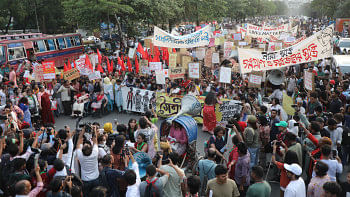Scarce facilities at land ports hamper bilateral trade: study
Inadequate facilities at the Benapole and Petrapole land ports hamper bilateral trade between Bangladesh and India, found a survey conducted by the South Asian Network on Economic Modelling (Sanem), a private think tank.
Some 37 percent of the respondents found the business operation hours at Benapole to be unsatisfactory, 20 percent adequate and 43 percent very poor.
The effective working hours in practice are from 10am to 2pm, meaning that instead of the eight hours of a working day, this port was effective for only four hours a day, says the survey. Among respondents at Petrapole, 36 percent found business operation hours at the Indian port to be unsatisfactory, 18 percent adequate and 46 percent very poor.
The situation is more or less the same in other areas, such as infrastructure, regulatory and administrative procedure, facilities and use of digital and advanced technology, capacity of the workforce, social and local conditions and basic utilities, including electricity and water.
Sanem disclosed the findings at a press conference at its office in Gulshan yesterday.
The USAID Asia, Middle East Economic Growth Best Practices Project (AMEG) and Bangladesh Trade Facilitation Activity (BTFA) supported Sanem in carrying out the survey. Selim Raihan, professor of economics at the University of Dhaka and executive director of Sanem, presented the findings of the report titled “Boosting Bangladesh-India bilateral trade: Are Benapole and Petrapole land ports ready to take the challenges?”
The think-tank carried out the survey to assess business needs of these two priority land ports that handle about 80 percent of land trade between the two countries, worth around $4 billion recorded in fiscal 2016-17. On an average, 350 trucks enter Bangladesh from India every day, whereas only 70-80 enter India from Bangladesh.
Private sector traders complain about delays stemming from burdensome processes, inconvenient operating hours and insufficient facilities and human resources at both sides. In case of infrastructure, such as equipment, transport and space facilities, at Benapole, some 62 percent found it to be poor and 30 percent unsatisfactory.
Infrastructure facilities are relatively better at Petrapole as 43 percent found it to be adequate, 37 percent unsatisfactory and 20 percent poor.
Regarding regulatory and administrative procedures, 26 percent of respondents in Bangladesh said it was poor whereas 28 percent said the same for India.
Some 70 percent of respondents said facilities and use of digital and advanced technology at Benapole are poor compared to 33 percent in India.Insufficient storage capacity is another major barrier for the port users, according to the survey.
“The findings of the study will be useful for the governments of India and Bangladesh in designing policies in order to boost trade between the two nations,” said Raihan of Sanem.
He said well-functioning business operation facilities and support systems at these land ports are essential to deepening connectivity between the two South Asian economies. The think tank also came up with some recommendations.
These include widening existing roads, building additional warehouses, incorporating advanced digital and technological facilities and policy level advocacy between the customs houses and between the governments.

 For all latest news, follow The Daily Star's Google News channel.
For all latest news, follow The Daily Star's Google News channel. 



Comments